


DARRICK WOOD HOUSE
It is easy to miss Darrick Wood House unless you frequent the small swimming pool off Lovibonds Avenue. The house today appears squeezed in between the baths and the road, but predates both. While not particularly old it once had 17 acres of grounds, and has an interesting history.
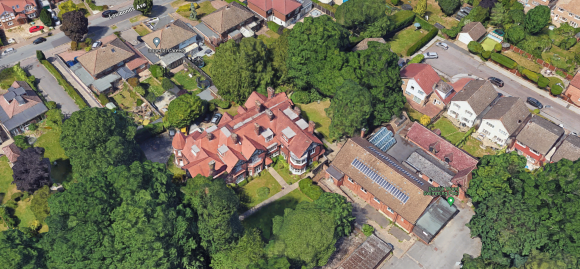
This article was written in 2016, and published in the June 2019 issue of the magazine of the Bromley Borough Local History Society, It is reproduced here by permission.
Click on maps and images to enlarge
History of Darrick Wood House
Darrick Wood House sits on a slight rise between two small shallow valleys. The grounds are all in the larger valley, which contains a stream — the Kydbrook — joined by the Tugmutton branch on the other side of the road which runs in front of the house. The Kydbrook runs north, joining the Ravensbourne River system leading to the Thames.However, the house is a relatively recent addition to this landscape in North West Kent in the area between the villages of Locksbottom and Farnborough, and Orpington Station. This is the Crofton manor, part of Orpington parish near the border with Farnborough.
Orchards were common locally in 1841 (on the early tithe map) but in the mid-1800s this was a rural area with extensive woods among farmland. The woods provided cover for game, which was an important part of the produce of the local estates.
The key landowner listed in the 1841 Orpington tithe record is Jane Waldo. Bordering her property is Darrick Wood— known then as Great Darrick Wood and still part of the extensive landholdings locally of St Thomas’s Hospital. Originally, all of Crofton manor belonged to the hospital. The land was donated to the Savoy Hospital charity by Sir Thomas Rede in the early 1500s, and then granted to St Thomas’s by Edward VI in 1553.
The 1863 OS map (scale 1:2500) and that of 1871 (scale 1:10000) show no boundary between the two woods and describe the whole area as “Darrick Wood”.
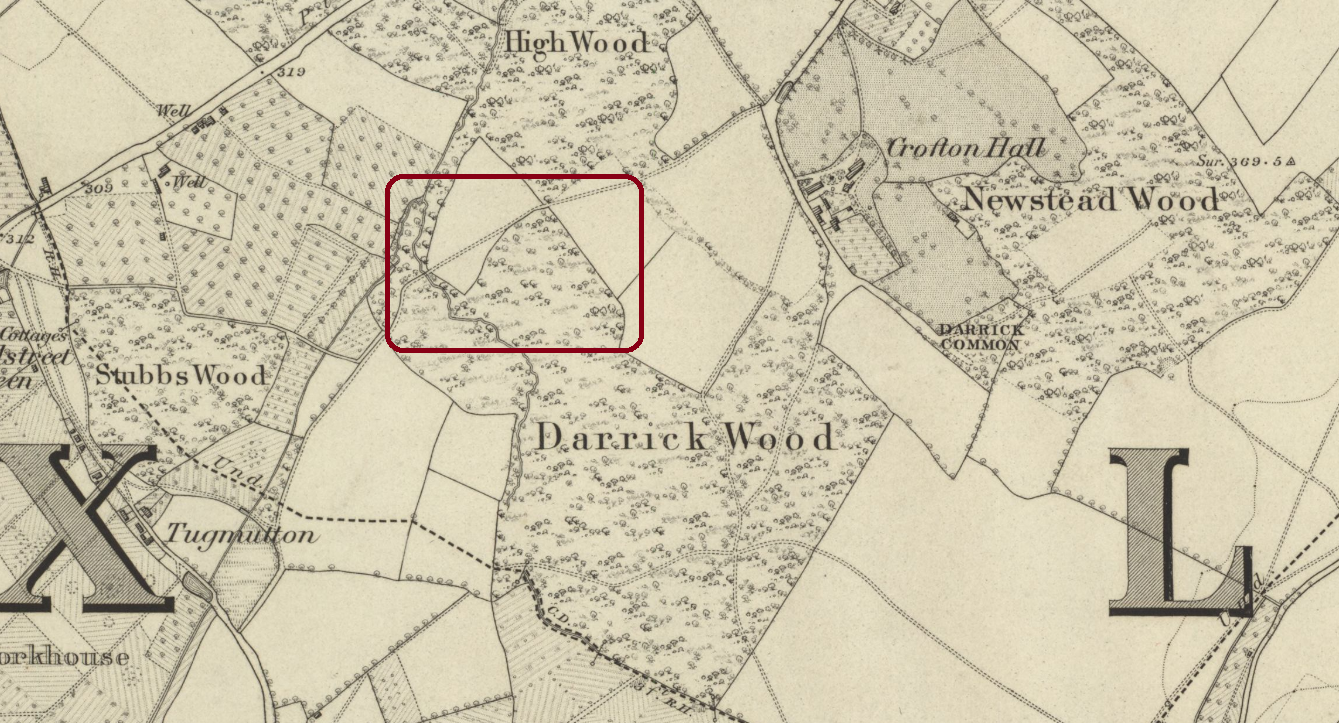
In this period the road to the north of the wood was a track and the stream wound through the wood. No farm or large manor house occupied this site.
All the older properties in the immediate area (eg Crofton Hall, Crofton Pound, Starts Hill Farm) are situated on higher hills or ridges.
Development — the private house
The 1896 OS map (scale 1:2500) shows the initial stage of development with a house now built in the north corner of the estate, next to the widened road. Other estate buildings are in place (stables, gardener’s cottage etc.) and the grounds are clearly landscaped.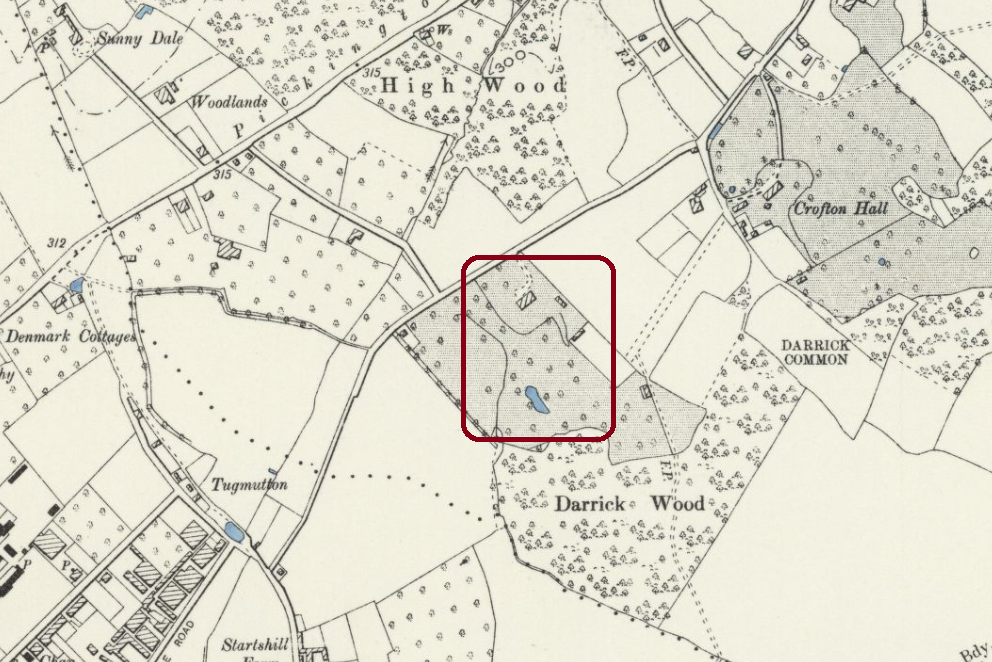
Most of the woodland has been replaced with open parkland. Key changes have been made to the boundaries of the 1841 woods and fields. Access has been improved from the east, the Crofton Hall road. The old track, now clearly the road known today as Lovibonds Avenue, and the stream are realigned and straightened. The stream is culverted under the road. The straight western boundary is a shelter belt of mixed coniferous and deciduous trees.
We now have a compact estate with straighter boundaries to its adjacent properties except on the Darrick Wood side. This may be one landowner improving access and drainage to allow development, or done in co-operation with the neighbours to allow exchange of land for mutual benefit.
The 1891 census lists Darrickwood House, Starts Hill, in Orpington parish. The owner is Reuben Preston, a hydraulic engineer. The house is large enough for his extensive family – wife, eight children (four sons, four daughters), visitors and staff. Other staff are listed as living in the gardener’s cottage and above the stables. It would be interesting to know if this land was acquired to have a house built or if it was inherited.
Around 1894/95 this family moved (Reuben Preston eventually died in 1913 at nearby Hayes Court), and the house was sold to a London surgeon, Robert Davis, who had been living in Epsom.
The 1896 OS map (scale 1:2500) probably shows the property as it was when the Davis family moved in. The 1901 census records his wife, sister in law, two sons and three daughters. There are extensions to the house – a new wing and conservatory — and to the stable block, and the small lake has an island. The parkland is now divided into smaller units, with extensive mixed tree planting along the drive and around the house. A small orchard is sited beside the road.
.png)
Robert Davis died in 1915 and his two sons were killed in action in 1916 and 1917. Mrs Davis lived in the house until the early 1920s when her health deteriorated and she moved to Eastbourne, where she died in 1928.
Newport Market Army Band School
The house was left empty and in 1926 Mrs Davis’s daughter Gwen sold it to a charity, the Newport Market Army Band School, who had sold their premises in Greencoat Place, Westminster. This was a Shaftsbury Society school for orphans or poor boys. Preference was given to boys with army connections, and the intention was they would join the Army on leaving school.The school moved in during March 1927 and was later formally opened by Princess Mary. There were 80 boys aged from 10 to14. A brief press cutting from that time states “… the boys have started to make allotments and trees have been felled to make a football and a cricket ground ... fowl and rabbit runs are to be started shortly. In addition there is a very large corrugated iron hut which is to be used for band practice and gymnasium work”. It also reports that “the Superintendent contemplates a swimming pool in the lake in the grounds”. In fact a benefactor provided the funds for a substantial brick-built swimming pool next to the old stable block (still in use today).
A further change is shown in the area of the stream. On the 1933 OS map this has been dammed, forming a small pond, and a footbridge installed.
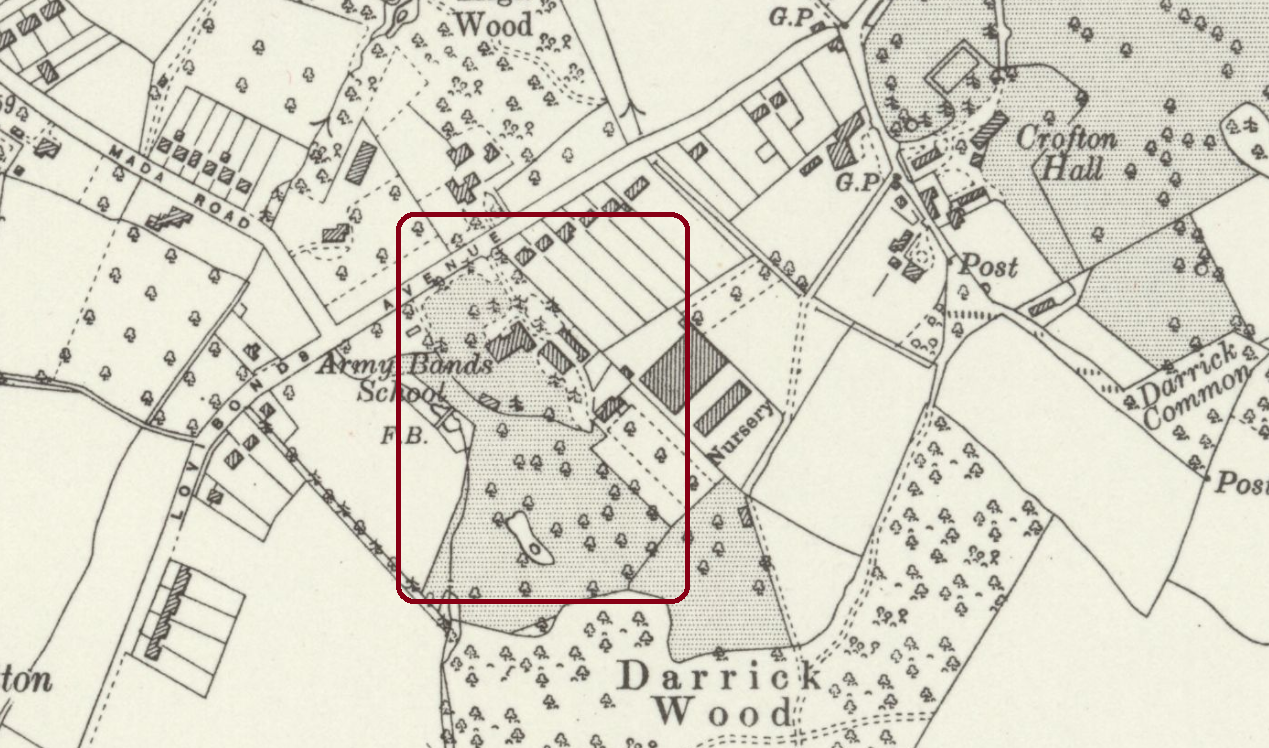
This was probably done to improve drainage and to give access to the western playing fields (where the trees were felled) across a very marshy area. The old kitchen garden is now shown as an orchard with part of the adjacent parkland added, presumably to increase the area available for cultivation.
Open days were held to raise donations, with the boys putting on athletics and swimming displays and the school band playing. The band could be hired and was in much demand locally. The school's Annual Inspection was a grand affair carried out by a senior military officer or members of the Royal Family with the public invited to attend. There was a Cadet Corps inspection followed by various gymnastic, boxing and swimming displays before the prize giving and speeches.
In 1933 Princess Alice and her husband the Earl of Athlone attended. Tea was served on the lawns for visitors while the band played the march ‘Darrick Wood’ outside the private dining room. The Princess presented various prizes including two for gardening and also planted a copper beech tree to commemorate her visit.
Hard Times — the Country Club and war years
In 1938 the decision was taken (on the casting vote of the chairman) to amalgamate the school with another of the charity’s schools at Twickenham because the financial outlays were not being covered by donations. Despite protests by local dignitaries, and letters to The Times, the move went ahead. The property was put up for sale for £5,000 – the area of land is given as 16 acres 2 roods 36 perches, the same size as the property owned by Dr Davis. It was bought by The Darrick Club Ltd, which paid £5,350 for the buildings and picturesque grounds.The property at the time is described as “nearly 17 acres of lawns and playing fields with a small lake, a stream with rustic bridges, in a glorious setting”. The company was to be owned by the members, who would each take a £1 share with subscriptions set at 10 shillings. Further money was to be raised to enable changes to the furnishings and layout of the grounds. Parking for 150-160 cars was planned and later a golf course. It appears that at least 300 people bought shares in early 1939. Open and local advertising continued to increase membership.
However the Second World War then intervened to disrupt the plans and finances, and the company was wound up in 1940. It appears that the bank took possession of the property to cover the mortgage.
An insurance company used the buildings as offices in the early part of the war but later moved to Orpington and the house was taken over by The Royal Corps of Signals, as was another former local school, Crofton Grange.
It is unclear exactly when, but there was further development between 1946 and 1960. In 1946, a press cutting mentions the launch of the Darrick Wood Youth Centre — the grounds and presumably the Baths — being used for sports courtesy of a Mr Brown, and this seems to continue throughout the period.
On the 1960s map we can see much of the land bordering the road is now developed.
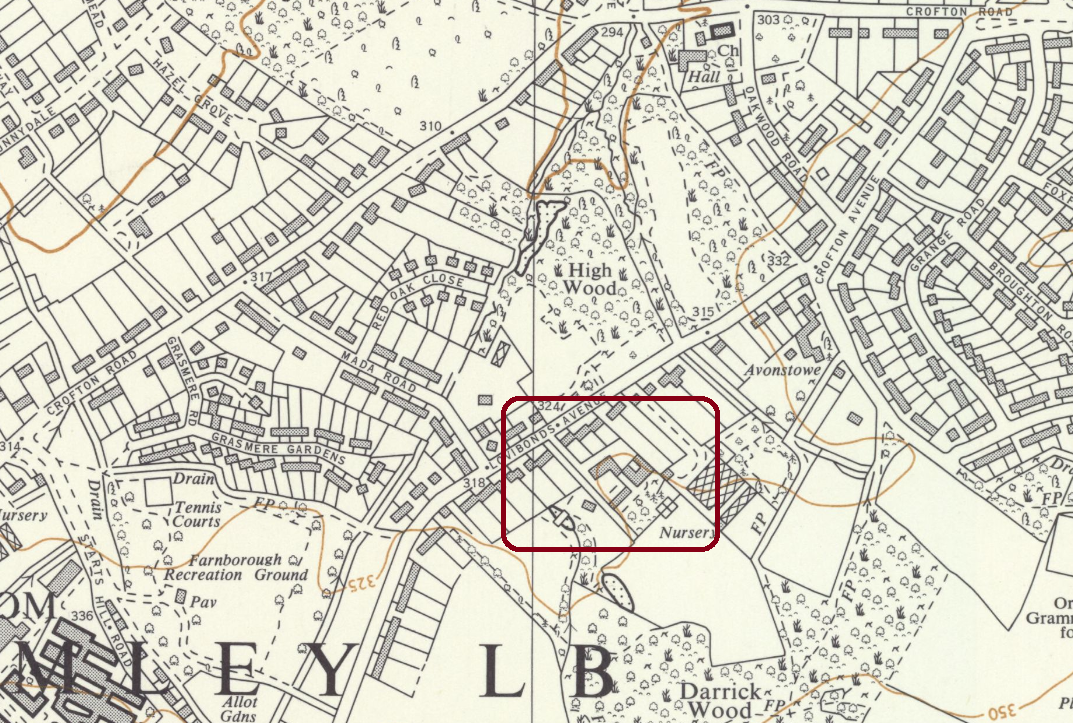
The small orchard is now an area of detached private houses and the original front drive and garden area have been redesigned to allow three pairs of substantial semi-detached homes to be built with a new narrower access road to the main house, which has been split into 11 luxury flats. A further road immediately parallel gives public access to the sports grounds and the baths area, and to the 11 garage block built behind the rear garden of the house.
Apart from small side gardens and parking at the front, this leaves the house with only a large square lawn at the rear. An area of parking for the baths is created behind the garages. The old Band Practice Shed is in use as changing rooms. The stream and lake areas are shown as open land at this time.
The remaining areas seem less well cared-for, with only limited work carried out to keep access and footpaths clear. The stream area is overgrown with young trees and undergrowth as time goes by and it is not clear what happened to the rustic bridges. The 1972 map shows marshy areas along the stream but the lake area appears to be relatively clear at this time.
Recent Developments - 1975 onwards
The final major development is the building of the Darrick Wood Senior School in 1975. This large school is built on the remnants of the western playing fields with an access entrance on the site of the old gardener’s cottage.
At this point the stream and lake areas appear to be retained by Bromley Council as publicly accessible land leading to the woodland known as Darrick Wood. The eastern playing fields are given to the school, eventually being fenced off.
However, with the formation of the volunteer Darrick and Newstead Woods Friends group in 2007, Bromley Council began a recovery programme and the stream and the lake is now included in the Darrick and Newstead Woods Local Nature Reserve which was formally opened in the summer of 2010.
Alan Filby